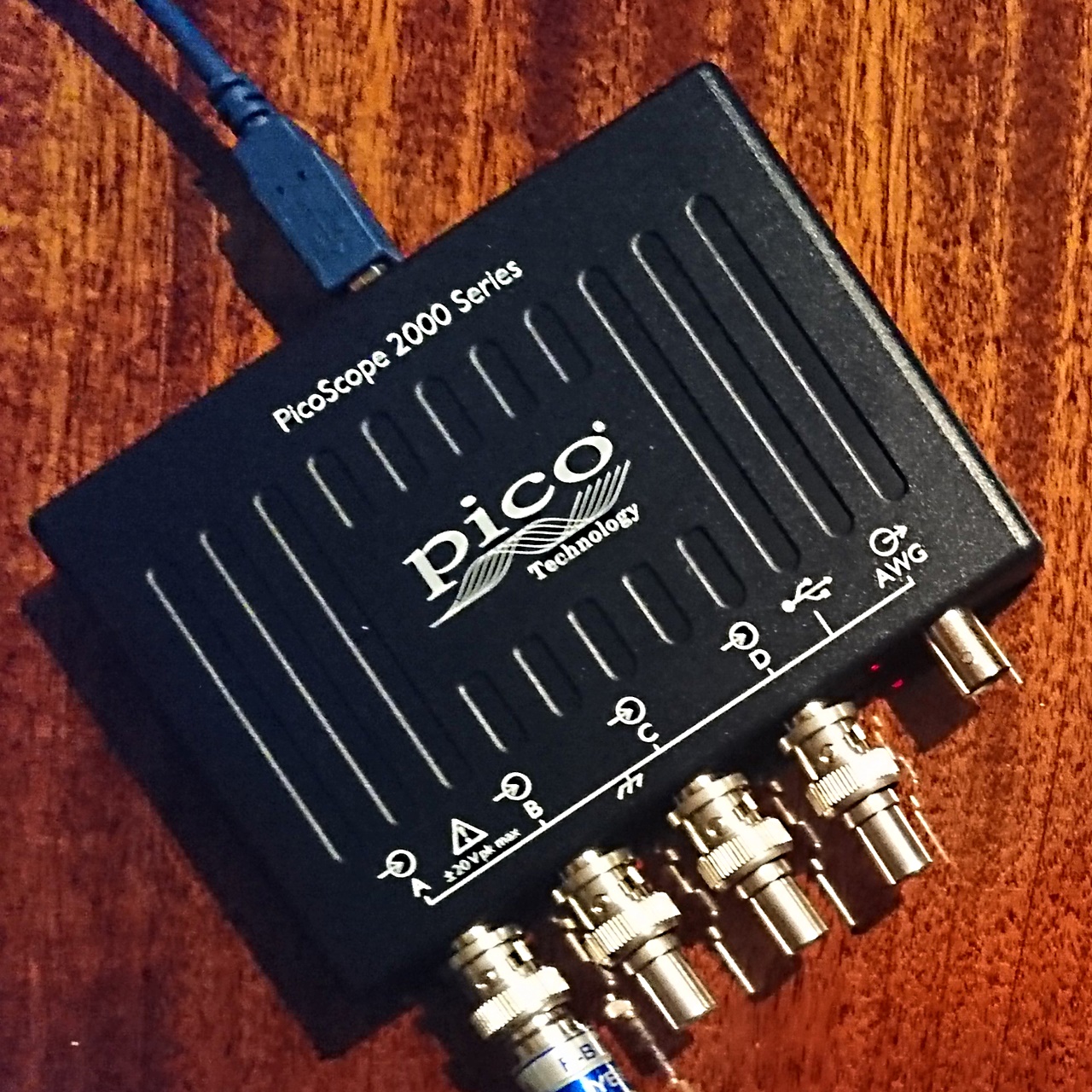PicoScope 2408B (100MHz, 4CH, 1GSa/s RTS, 20GSa/s ETS, 128MB memory, AWG) USB oscilloscope rolling review + general 2000 series threadEven as a long time PicoScope owner (2205 (2010my), 2205 MSO (2013my)), was quite surprised by my new 2408B on several fronts. So decided to do "rolling review" on it and learn how to properly max out it's capabilities in progress. Currently planned: bandwidth & sampling rate limits; vertical / horizontal / automated measurements accuracy; advanced mask testing; FFT; decoding; bode plot (incl. phase), some math trickery.
If any additional interests, please ask..

First task/test was to actually find out specs. Included here are those I see as most important and ones missing / different in
official specs (emphasized in green). Scope performance relies heavily on PC software - so guess they forgot to update specs, while software got better. PC itself also plays large part, mine is Lenovo W520 laptop, Intel i7-2720QM, 8GB RAM, 64-bit Windows 7. So reasonably fast, but probably not enough to totally max out scope.
Disclaimer: review/test is done in non-controlled environment by non-professional. Use this info at own risk & responsibility
 2408B SPECIFICATIONSOscilloscope - vertical
2408B SPECIFICATIONSOscilloscope - verticalAnalog bandwidth: 100MHz
Rise time (calculated): 3.5ns
Vertical resolution: 8bit (up to 12bit averaging)
Input coupling: AC/DC
Input ranges: +-20mV...+-20V (4mV/div...4V/div)
Vertical DC offset range: ±250mV (±20mV to ±200mV ranges); ±2.5V (±500mV to ±2V ranges); ±25V (±5V to ±20V ranges)
DC zero level calibration:
on-the-flyDC accuracy: ±3% of full scale ±200uV
Offset control accuracy: ±1% of offset setting, additional to basic DC accuracy
Overvoltage protection: ±100V (DC + AC peak)
Oscilloscope - horizontalReal time sampling rate (RTS):
any 1 ch 1GSa/s; any 2 ch 500MSa/s; any 3-4 ch 250MSa/sEquivalent time sampling rate (ETS):
any 1-4 ch 20GSa/sTimebases (RTS): 1ns/div...5000s/div
Timebases (ETS):
50ps/div...200s/divMax timebase at max sampling rate (RTS, Single trigger, fast sampling):
10ms/divMax timebase at max sampling rate (RTS, None|Auto|Repeat triggers, fast sampling):
5ms/divMax timebase at max sampling rate (RTS, Rapid trigger, fast sampling):
1ms/divMax timebase at max sampling rate (ETS):
50ns/divMax memory (RTS, Single trigger, fast sampling):
any 1ch 1x120MB; any 2ch 2x60MB; any 3ch 3x30MB; 4ch 4x30MBMax memory (RTS, None|Auto|Repeat triggers, fast sampling):
any 1ch 1x60MB; any 2ch 2x30MB; any 3ch 3x15MB; 4ch 4x15MBMax memory (RTS, Rapid trigger, fast sampling):
any 1ch 1x13x9.5MB; any 2ch 2x13x4.75MB; any 3ch 3x13x2.375MB; 4ch 4x13x2.375MBMax memory (RTS, None|Auto|Repeat|Single triggers, slow sampling):
any 1ch 1x95MB; any 2ch 2x48MB; any 3ch 3x32MB; 4ch 4x24MBMax memory (ETS):
any 1-4ch 1-4x16,380kBWaveform buffers: 10,000
Maximum waveforms per second (
RTS, persistence mode): 80,000
Maximum waveforms per second (RTS, Rapid trigger): >1,000,000Initial timebase accuracy: ±50ppm
Timebase drift: ±5ppm / year
Sample jitter: 3ps RMS typical
ADC sampling: Simultaneous
Dynamic performanceCrosstalk (full bandwidth, equal ranges): Better than 300:1
Harmonic distortion: <–50dB at 100kHz, full-scale input, typical
SFDR (100 kHz, full-scale input, typical): ±20mV range: >44 dB; ±50mV range and higher: >52 dB
Noise: <30uV RMS (±20mV range)
Bandwidth flatness: (+0.3dB, –3dB) from DC to full bandwidth
TriggeringTrigger rearm time in rapid trigger mode: <1us on fastest timebase
Max. waveforms in rapid trigger mode: 10,000
Function generatorStandard signal frequency: 1MHz
AWG update rate: 20MHz
AWG buffer: 32kB
AWG Resolution: 12bit
AWG bandwidth: >1MHz
AWG rise time (10%...90%): <120ns
Spectrum analyzerFrequency: 0...100MHz
FFT points: 1M
FFT channels:
all physical channels * viewports (same physical channel may be in different viewports, zoomed in different way) * math channels = manyMask testingModes:
YT, XY, FFTMask channels:
estimated (12 viewports * 4 ch) = 48 masks simultaneousAutomatic measurementsAccuracy:
4-digit rounded at UI level, internally high precision floating point (can be accessed using "hacking")DisplayInterpolation: Linear or sin(x)/x
Persistence modes: Digital color, analog intensity, custom, fast or none
Zoom:
100Mx horizontal, 50x vertical in any timebase + offset + custom zoomConnections4xCH BNC; AWG; USB 2.0
Serial decoding (1-Wire, ARINC 429, CAN,
CAN FD, DCC, DMX512, Ethernet 10Base-T, FlexRay, I²C, I²S, LIN, PS/2, SENT Fast, SENT Slow, SPI, UART/RS-232/
RS-422/
RS-485, USB (
1.0/1.1))
Other featuresmath channels; event actions; supplied probes: 4xTA132 (1x/10x, 150MHz)
incl. BNC adaptorsANALOG BANDWIDTH TESTVERTICAL SYSTEM INTEGRITY TESTDC ACCURACYFREQUENCY COUNTING ACCURACYMICROPHONICSCUSTOM PROBESDIGITIZING ANALOG SIGNALS USING TRIGONOMETRYDADC / VIRTUAL MSO USING EXTERNAL DACFREQUENCY RESPONSE ANALYSIS TOOLS